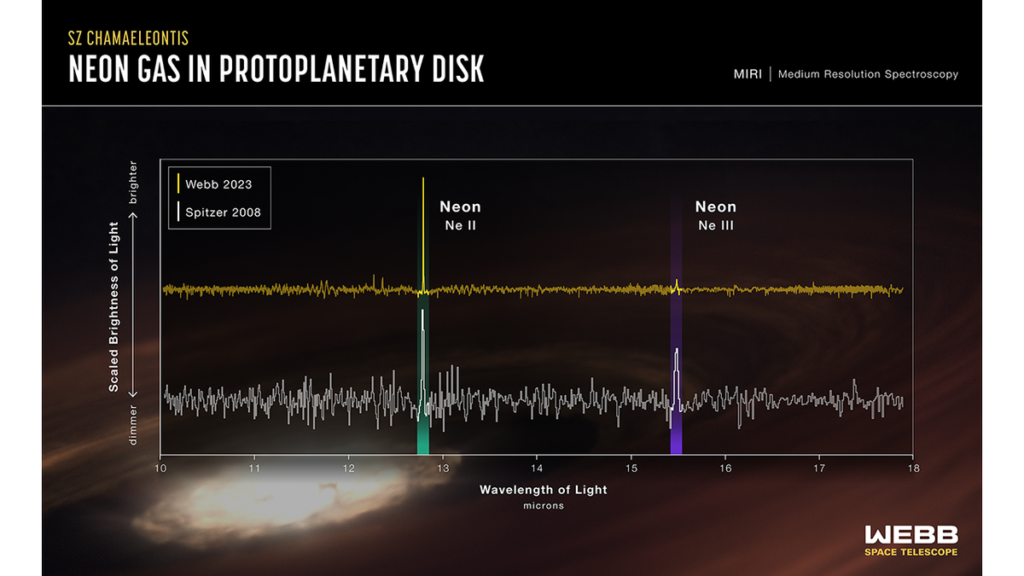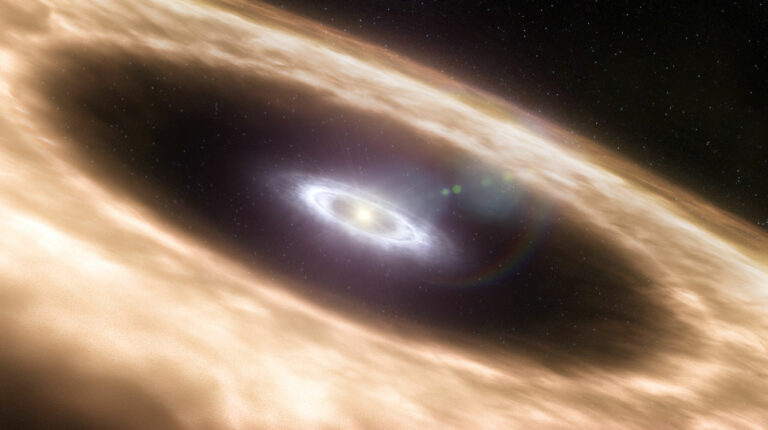James Webb Space Telescope Unveils Initial Observation of Vanishing Neon Surrounding a Newly Formed Star
Planets in the process of formation around the youthful star SZ Cha should hasten their development.
Recent observations from the James Webb Space Telescope indicate that the quantity of ionized neon gas within dusty, planet-forming disks can provide insights into the rapidity with which planets must form before the disk itself dissipates.
The prevailing understanding is that planets come into existence within disks composed of gas and dust encircling newly formed stars. While astronomers have previously studied these disks, the overall planetary formation process spans hundreds of thousands, if not millions, of years. Consequently, these disks typically undergo changes over extended periods, and the observed features appear as frozen snapshots in time.
However, the James Webb Space Telescope has now documented a significant transformation in one planet-forming disk. In 2008, a team led by Catherine Espaillat, then affiliated with the University of Michigan and currently at Boston University, utilized NASA’s Spitzer Space Telescope to identify an infrared emission line linked to doubly ionized neon ([Ne III]). This signal emanated from a planet-forming disk encircling the youthful star SZ Chamaeleontis (SZ Cha). Ionization occurs when an outer electron of an atom is displaced by a high-energy photon, and “doubly ionized” atoms involve the loss of two electrons due to the impact of two photons.
Upon its initial detection, the presence of [Ne III] in SZ Cha’s disk was deemed an anomaly, especially considering that most disks are typically exposed to X-ray radiation from their young parent stars. Its existence suggested that, contrary to expectations, lower-energy radiation in the form of extreme ultraviolet (EUV) must be the prevailing radiation field in the SZ Cha system. EUV radiation is believed to gradually erode the gas and dust within the planet-forming disk, breaking apart molecules. However, it is presumed to be less effective in disintegrating disks compared to the rapid erosion caused by X-rays, which can occur 100 times faster than ultraviolet light.
Consequently, the rate at which a disk “evaporates,” and thus the timeframe available for planet formation before the disk dissipates, hinges on the energy of the radiation present.
Yet, in a follow-up study in 2023 using the James Webb Space Telescope’s Mid-Infrared Instrument (MIRI), Espaillat and her team discovered that the doubly ionized neon had significantly diminished compared to the quantity of singly ionized neon [Ne II]. This decrease in doubly ionized neon suggests that X-ray radiation, rather than ultraviolet radiation, has emerged as the predominant radiation field in the SZ Cha system.
This finding could have significant implications for our understanding of the timeframe in which planets must form before their disk undergoes dissipation.
“In computer models of developing systems, extreme ultraviolet radiation allows for one million more years of planet formation than if evaporation is predominantly caused by X-rays,” explained Thanawuth Thanathibodee from Boston University. Therefore, the abundance of doubly ionized neon can serve as an indicator of the balance between ultraviolet and X-ray radiation affecting a planet-forming disk at a specific moment. By gauging its abundance, astronomers can more accurately determine the timescale within which planets must form before the associated birthing disk disappears.

Complementary observations from ground-based sources have contributed another element to the puzzle. The CHIRON spectrometer on the SMARTS 1.5-meter telescope at the Cerro Tololo Inter-American Observatory detected “blueshifted” hydrogen-alpha emissions linked to the star in the SZ Cha system. Blueshift, akin to a Doppler shift, indicates that something in the distant universe is moving toward us—in this scenario, the hydrogen.
Scientists interpret this phenomenon as a “stellar wind,” a flow of particles emanating from the star and heading closer to our region of the cosmos. The wind is believed to be sufficiently dense to absorb ultraviolet light while still allowing the passage of X-rays, thereby enabling X-ray radiation to dominate the evolution of the star system. The absence of doubly ionized neon in 2023, compared to its presence in 2008, suggests that the wind may be variable and potentially linked to the type of radiation influencing the star system’s planet-forming disk.
Further investigations are in the planning stages, involving not only the JWST but also other observatories covering various segments of the electromagnetic spectrum. This comprehensive approach aims to unravel the complexities of the SZ Cha system, particularly in understanding the fluctuations in the stellar wind. Catherine Espaillat emphasized, “We need to rethink, re-observe, and gather more information. We’ll be following the neon signs.”
A paper about these findings was published on Wednesday (Nov. 15) in The Astrophysical Journal Letters.
Do not forget to share your opinion with us to provide you with the best posts !




0 Comments